Physical Address
304 North Cardinal St.
Dorchester Center, MA 02124
Despite many advances in the quality and availability of less invasive arterial imaging modalities, arteriography remains the “gold standard.” Alternative modalities, such as duplex arterial mapping, computed tomographic angiography (CTA), and magnetic resonance angiography (MRA), are being used with increasing frequency because of improved image quality and minimal risk. For some clinical scenarios, such as duplex surveillance of lower extremity vein bypass grafts, these imaging techniques have supplanted arteriography as the preferred test. However, arteriography remains an indispensable tool for the vascular surgeon. A comprehensive understanding of basic to advanced techniques permits a wide array of arteriographic imaging studies to be performed optimally. In addition, a wide breadth of knowledge about arterial anatomy, equipment and materials, potential complications, and sources of interpretation error are required for becoming an expert in performing arteriography.
The goal of this chapter is to impart a broad overview of modern arteriography. Clinical acumen about vascular disease and operative experience also play important roles in determining how to optimize arteriographic imaging. This chapter provides evidence-based guidance, as well as practical experience, for safe performance of high-quality arteriography.
The task to determine what equipment is needed to perform high-quality arteriography can seem overwhelming. The necessary components can be divided into venue, imaging hardware, catheters, contrast agents, devices for delivery of contrast agents, and digital software used to assist in the processing of arteriographic images. Image processing closely relates to techniques of arteriography and is discussed later in the chapter.
Depending on facility-specific logistics, angiography can be performed with a portable fluoroscopy unit or in a designated interventional suite with a fixed imaging unit. Many centers contain “hybrid operating rooms,” featuring a fixed-mount imaging unit combined with all the features of an operating room, a fully equipped endovascular stock (catheters, guide wires, and devices), and a trained staff that is proficient in endovascular and open vascular surgery.
The advantages of an operative-endovascular or hybrid suite are clear. Combined endovascular and open procedures are common. Aortic endograft procedures, common femoral endarterectomy with concomitant retrograde or antegrade stenting and hybrid approaches to acute limb ischemia have evolved into the “standard of care.” Lastly, complications that arise during any endovascular procedure, albeit rare, can be managed by immediate and seamless conversion to open surgery, obviating the need for emergency transport from an interventional suite to the operating room.
The two principal types of radiographic imaging units that can provide state-of-the-art arteriography are the fixed-mount unit ( Fig. 27.1 ), and the portable fluoroscopy unit equipped with wheels so that it can be moved from room to room ( Fig. 27.2 ). Each type has the basic components, including a power generator for fluoroscopy, a C-arm with image intensifier, screens for viewing real-time and reference images, and digital image processing software. In experienced hands, both types of imaging units have their advantages and disadvantages. Fixed units, while previously mounted to the ceiling or floor are also now available on a gantry that travels on pre-defined paths using laser guidance in the hybrid OR setting. This allows the unit to be parked in the corner of the room, out of the way, when not needed.
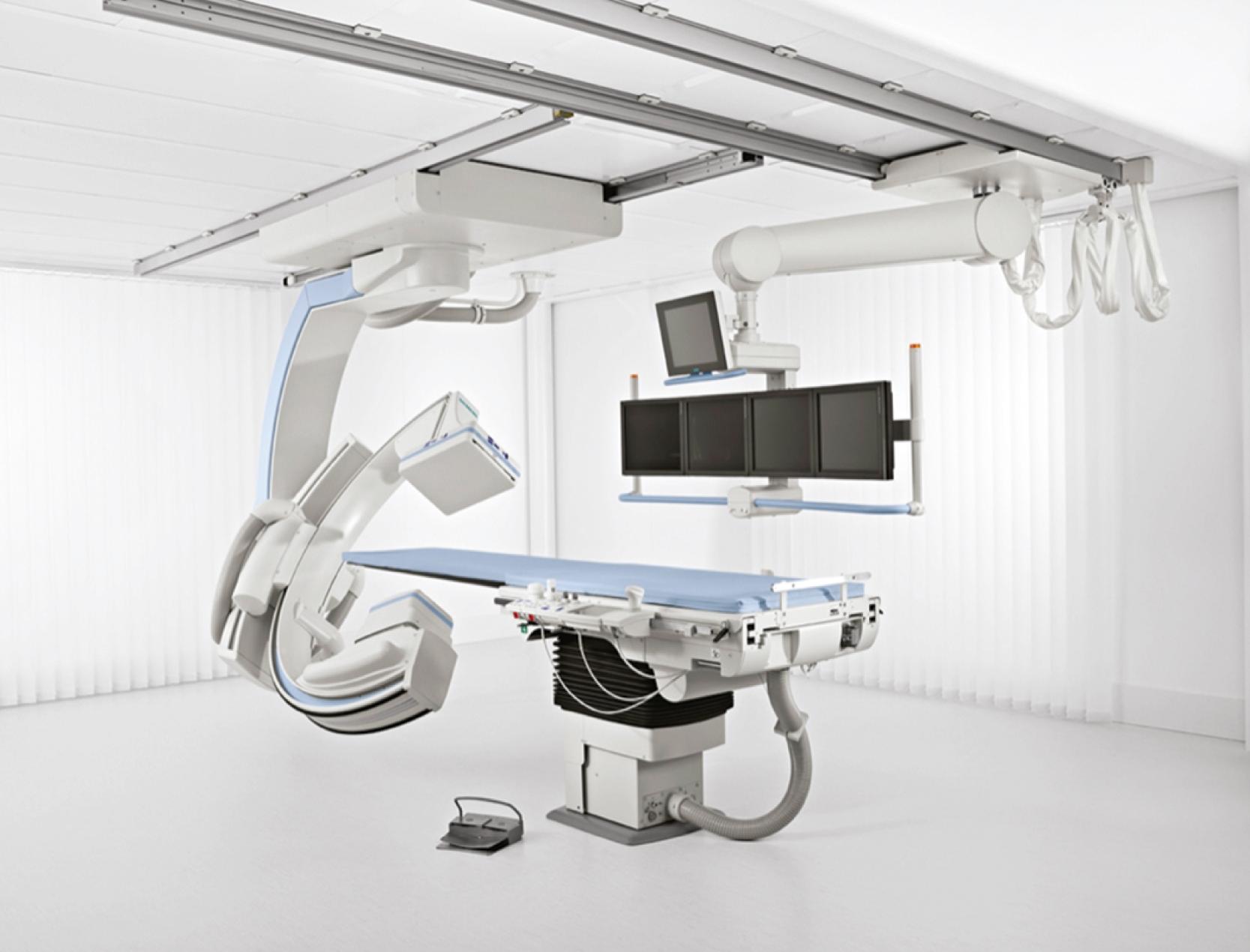
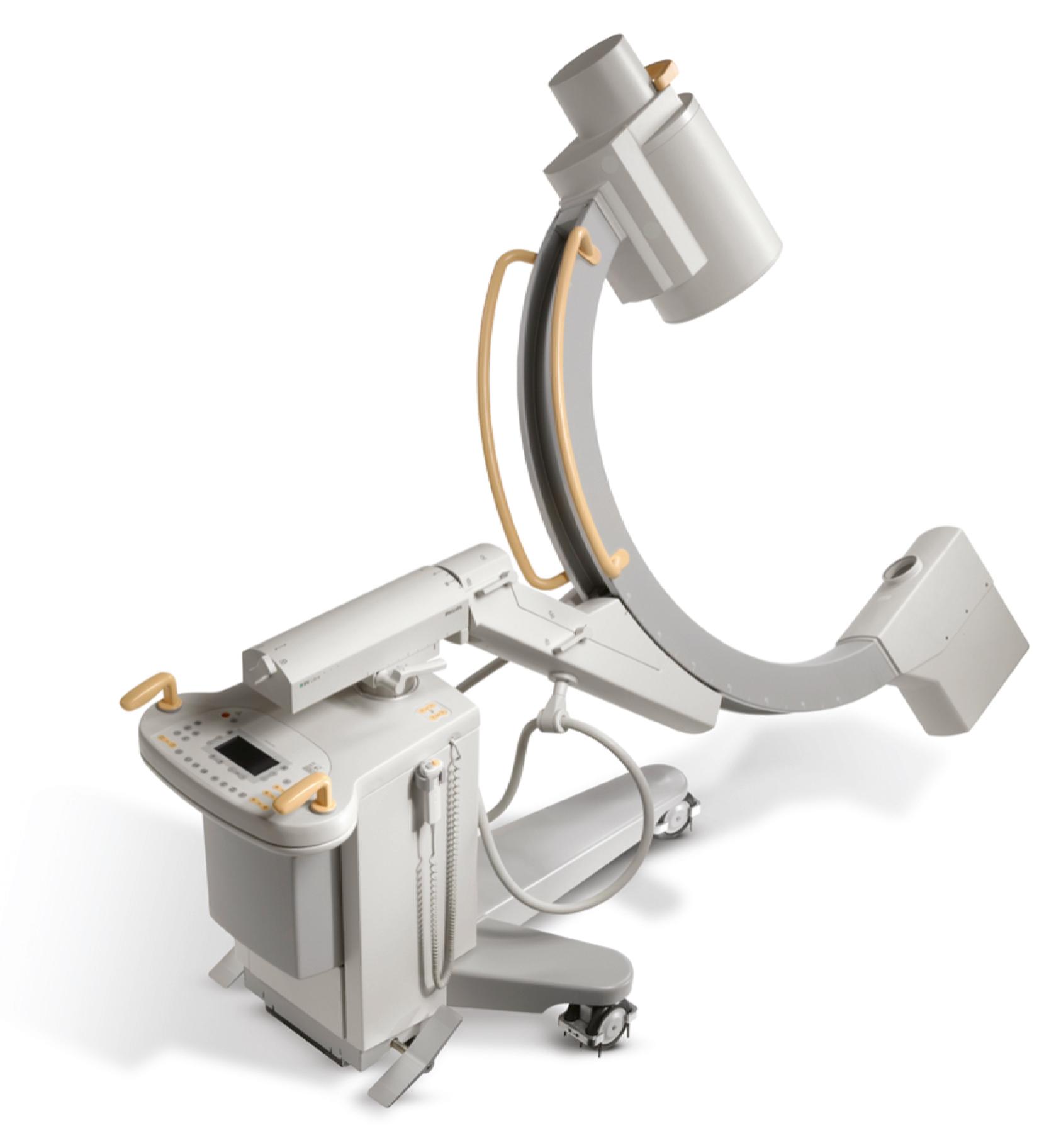
In general, fixed-mount units have more powerful generators that allow more detailed imaging. More power allows greater depth of fluoroscopic penetration and thus the ability to discern finer detail. Depending on the types of imaging units compared, fixed-mount units can provide upward of 10 times the resolution of portable units. Although this greater resolution may not be needed in persons of ideal body weight, increased power for improved penetration is important when arteriography is performed on obese patients. Another distinct advantage of a fixed-mount unit is a larger field of view. Modern fixed-mount units now have flat detector image intensifiers as large as 22 inches (57-cm image projection). This increased size translates into the ability to cover more imaging area during arteriography with less radiation exposure and lower total volume of contrast material. In addition, fixed-mount units have tableside controls that allow precise and easily directed movement of the C-arm and table. This feature is useful during visceral and cerebrovascular arteriography where minute manipulations in C-arm angulation can result in significantly improved arterial visualization.
A portable fluoroscopy unit designed for high-quality arteriography is advantageous by the mere ability to move the equipment from room to room. This may be important in trying to fulfill the needs of different types of vascular surgical practices, operating rooms, specialty procedure rooms, and intensive care units. Depending on the setting, portable fluoroscopy units may require only one technician in addition to the vascular surgeon for arteriography to be adequately performed, although a nurse able to monitor the patient when moderate sedation is used is often required as well. Fixed-mount units may require three or four specially trained staff, including a technician who is gowned and gloved with the vascular surgeon, a circulator attending to material needs, a technician coordinating image acquisition and processing, and a certified nurse who is responsible for monitoring the patient and administering medications. Finally, portable units are much less costly than fixed-mount units. Not only are fixed-mount units expensive (ranging from $1.5 to $5 million), but construction of such a suite may require major structural modifications to an existing room, which can be a significant additional cost.
The type of catheter used also plays an important role in optimizing the arteriographic image and avoiding injury to the vessel. Intraarterial catheters come in virtually all shapes, sizes, wire compatibilities and lengths. Given this variety, attention should be paid to whether the catheter has just an end hole or multiple side holes in addition to the end hole ( Fig. 27.3 ). The latter, known as a flush catheter, is designed for safe, quick, and even dispersion of contrast material at high injection pressures to image large arteries with high flow. These are typically used for aortoiliac arteriography or venography of the iliac veins or vena cava. End-hole catheters, with their greater variety of shapes and sizes, are often all that can be used after remote arterial access is achieved. Care should be taken whenever a power injection is performed with an end-hole catheter in a medium-sized artery. Problems may include loss of a tenuous catheter crossing because of pressure forcing the catheter out of the arterial lumen, creation of intimal flaps, and arterial rupture. Power injection into very small arteries, such as the vertebral or tibial arteries, should be avoided with any type of catheter. Controlled hand injection with either a manifold or syringe should also be performed gently to avoid injury to these vessels.
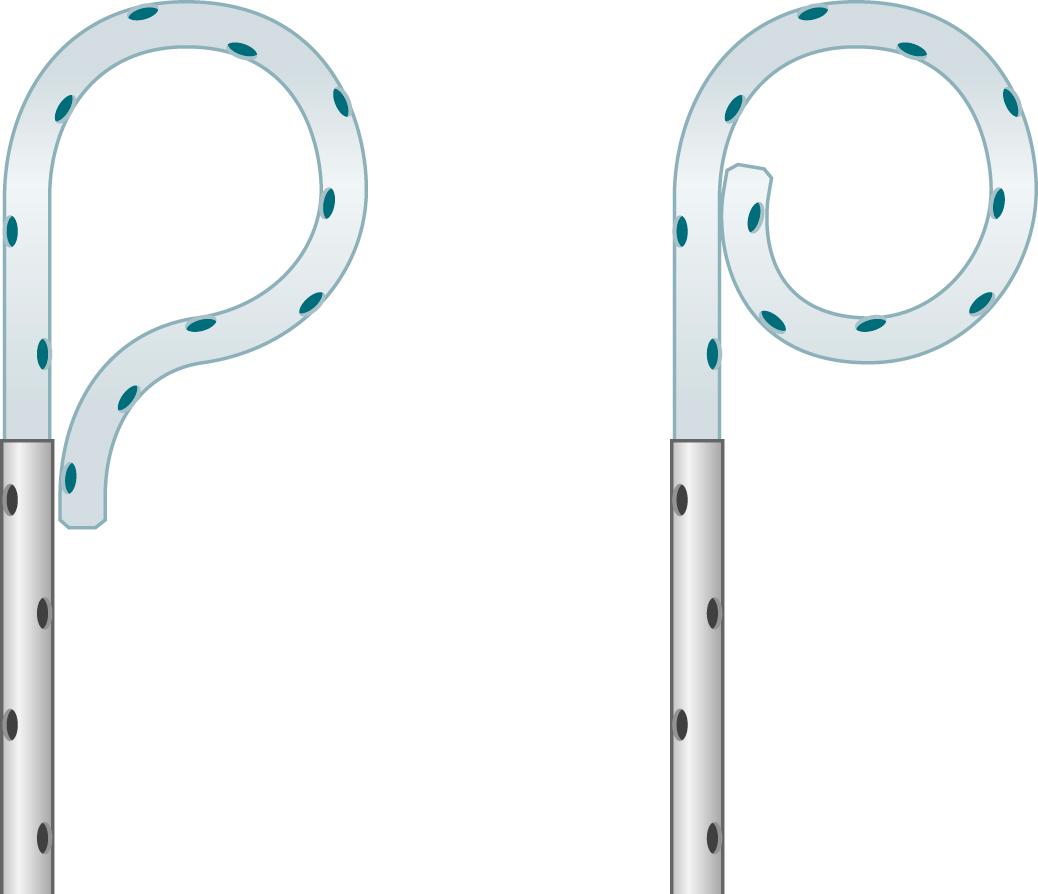
The concept of angiographic imaging relies on the presence of an intravascular contrast agent. To maximize vascular anatomic detail, this agent needs to have a radiodensity that is distinct from that of the tissue being imaged. Typical contrast agents have greater radiodensity than surrounding tissue and therefore appear markedly darker on imaging. However, an agent significantly less radiodense than surrounding tissue, such as carbon dioxide (CO 2 ) gas, can also provide adequate contrast to image intravascular anatomic detail, , albeit with less quality in some cases. The underlying concept is to provide adequate visual contrast between the intravascular space and the extravascular space. Selecting the appropriate contrast agent and adjusting the imaging equipment and technique accordingly are essential for patient safety and imaging quality.
Conventional contrast agents are composed of molecular compounds containing iodine. These iodinated agents can be categorized as ionic or nonionic.
Ionic contrast agents dissociate into anions and cations when they are placed in solution, which includes flowing blood. The anion is a benzene ring fully substituted with three iodine atoms. Iodine atoms absorb the X-ray photons and are responsible for contrast visualization, or radiopacity, of the artery visualized. The cation can be sodium, methylglucamine, or a combination thereof. When iodinated contrast agents dissolve, their osmolality doubles because of the presence of two ions. The osmolality of these agents ranges from 1500 to 1700 mOsm, thus making them significantly more hyperosmolar than plasma (285 mOsm).
Nonionic contrast agents have considerably less osmolality. Because dissolution of the benzene compound into two ions is prevented, the osmolality remains half that of ionic contrast agents. However, because the number of iodine atoms remains the same, radiopacity remains comparable to that of conventional ionic agents but with much less ionic charge. Osmolality can be further reduced by a compounding method that creates a dimeric ionic contrast agent, whereby two benzene rings are attached to each cation. With this formulation, twice the number of iodine atoms are present with the same level of osmolality (ranging from 320 to 880 mOsm). Doubling of the iodine atoms leads to a greater amount of X-ray photon absorption, and thus comparable arteriographic images are achieved with less volume of contrast material ( Table 27.1 ).
| Contrast Agent | Manufacturer | Structure | Iodine Content (mg/mL) | Osmolality (mOsm/kg) | Average Wholesale Cost (50 mL) |
|---|---|---|---|---|---|
| Hexabrix | Mallinckrodt Medical | Ionic dimer | 320 | 600 | $53.50 |
| Isovue-200 | Bracco Diagnostics | Nonionic | 200 | 413 | $53.75 |
| Isovue-300 | Bracco Diagnostics | Nonionic | 300 | 524 | $57.49 |
| Isovue-370 | Bracco Diagnostics | Nonionic | 370 | 796 | $62.50 |
| Optiray 160 | Mallinckrodt Medical | Nonionic | 160 | 355 | $39.60 |
| Optiray 320 | Mallinckrodt Medical | Nonionic | 320 | 702 | $57.60 |
| Omnipaque 140 | GE Healthcare | Nonionic | 140 | 322 | $38.94 |
| Omnipaque 300 | GE Healthcare | Nonionic | 300 | 672 | $54.00 |
| Omnipaque 350 | GE Healthcare | Nonionic | 350 | 844 | $58.81 |
| Oxilan 300 | Cook Corporation | Nonionic | 300 | 585 | $45.00 |
| Oxilan 350 | Cook Corporation | Nonionic | 350 | 695 | $50.00 |
| RenoCal-76 | Bracco Diagnostics | Ionic | 370 | 2188 | $24.25 |
| Renografin-60 | Bracco Diagnostics | Ionic | 292 | 1549 | $44.13 |
| Ultravist 150 | Bayer | Nonionic | 150 | 328 | $19.80 |
| Ultravist 240 | Bayer | Nonionic | 240 | 483 | $22.80 |
| Ultravist 300 | Bayer | Nonionic | 300 | 607 | $25.20 |
| Ultravist 370 | Bayer | Nonionic | 370 | 774 | $28.80 |
| Visipaque 270 | GE Healthcare | Nonionic | 270 | 290 | $63.80 |
| Visipaque 320 | GE Healthcare | Nonionic | 320 | 290 | $69.48 |
Another contrast agent with novel properties and applications is CO 2 . , Injection of this gas with its decreased radiodensity creates radiographic contrast by transiently displacing blood from the artery being imaged. Improvements in equipment, technology, and image-processing software, coupled with the significant number of vascular patients who have compromised renal function, have led to increased use of CO 2 arteriography. Digital subtraction technology has greatly enhanced anatomic definition and visualization with this contrast agent. However, despite improved techniques, image quality still remains inferior to that of conventional contrast agents.
Many techniques can enhance the quality of CO 2 arteriography. Because of the image settings developed to enhance visualization of intravascular CO 2 , the presence of bowel gas can especially degrade image quality in this acquisition mode. Because CO 2 rapidly displaces blood and then dissolves quickly, frame rates are increased during image acquisition (four to eight frames per second). Modern arteriographic imaging systems now feature prescribed settings that depend on the type of contrast agent and area of the body to be imaged. Further image enhancement can be achieved by selective catheterization and magnified views of smaller-caliber vessels ( Fig. 27.4 ). Contrast injections may be performed rapidly by hand or with a power injector system. They should be spaced 3 to 5 minutes apart to allow complete dissolution before the next injection. Overestimation of the degree of stenosis can occur when one is unable to completely fill the diameter of the artery with CO 2 . One technique for facilitating rapid CO 2 injection utilizes a flow switch attached to the Luer-Lok syringe. The flow switch is kept closed during the initial compression of the syringe plunger and then opened with continued compression on the plunger, which allows for more rapid and higher pressure delivery of the CO 2 . For lower extremity arteriography, Trendelenburg positioning or elevation of the extremity to approximately 20 to 30 degrees will slow distal blood flow and promote concentration of the CO 2 , thus slowing the dispersion rate as CO 2 exits the catheter and travels distally.
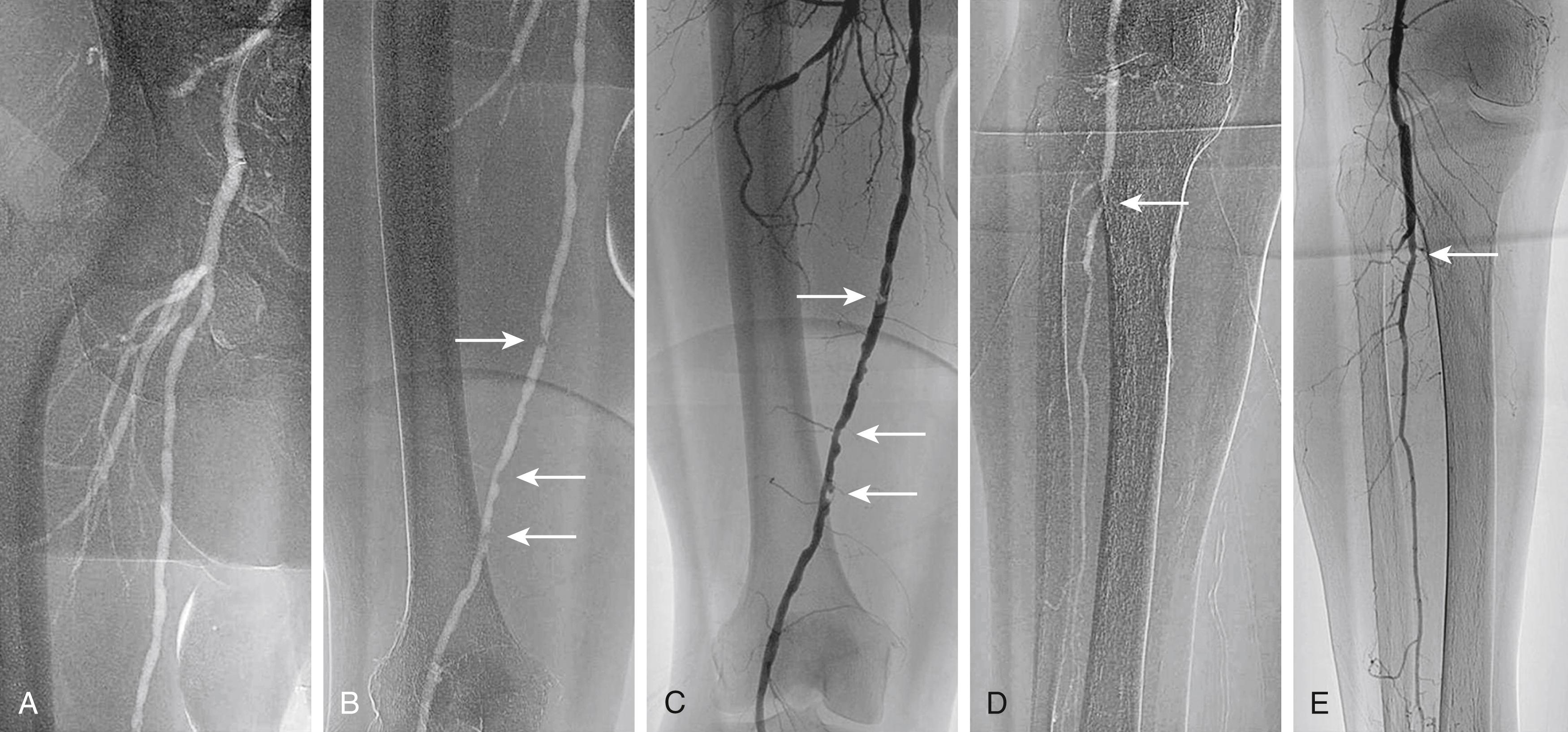
The CO 2 delivery system includes a 30- to 60-mL Luer-Lok syringe, tubing with a two-way distal stopcock and two one-way check valves, a 1500-mL fixed-volume gas bag, and the CO 2 tank ( Fig. 27.5 ). After assembly of the system, purging of the tubing with three syringe volumes (90 to 180 mL) of gas prevents the possibility of accidental injection of air. Nitrogen gas in ambient air is not soluble and can lead to gas embolization. Once the gas bag is filled with CO 2 directly from the gas reservoir, the syringe is pulled back to be filled with gas from the gas bag. Because of a one-way valve distal to the syringe, only gas from the bag can be withdrawn. Another reversed one-way valve proximal to the syringe forces gas to travel only to the patient on injection.
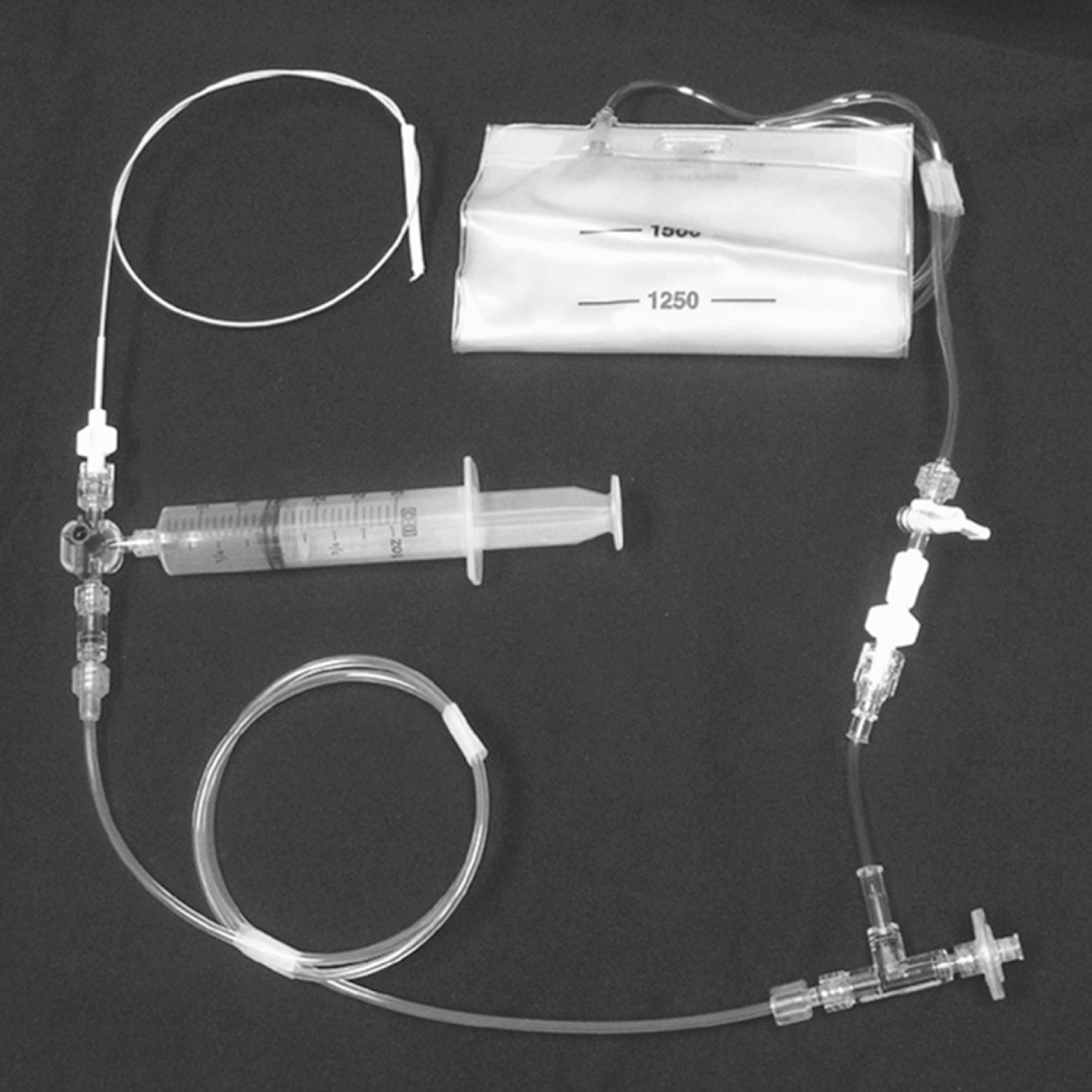
Injection of liquid contrast material can be performed with a power injector or manually. For optimal arteriography, the ability to perform both methods is preferable because both have distinct advantages, depending on which arteries are being imaged.
Power injectors allow rapid high-pressure injection of contrast material into the catheter. Precise control exists with regard to the pressure setting, measured in pounds per square inch (psi), amount of contrast material injected during a set period, timing of injection in relation to fluoroscopic imaging and catheter position, and rate of rise of the injection. Typically, use of a power injector allows for rapid filling of large arteries at high flow rates. This produces equal distribution of contrast material and hence a higher-quality image. Power injectors can also be used for prolonged injections, generally ranging from 3 to 6 seconds, when the catheter can be placed only in a very proximal position and the target artery is remote. Imaging of the dorsalis pedis and plantar arteries with the catheter placed in the ipsilateral common femoral artery is one such example. When a power injector is used, settings must be adjusted to manipulate pressure and the rate of rise of the injection, depending on the vessels being imaged. Large high-flow arteries require high pressure (800 psi) and rapid rise of the injectate to quickly disperse the contrast agent for a proper image. Smaller arteries, such as the superficial femoral artery, can be traumatized by such settings and require a lower pressure setting (300 to 600 psi) and reduced rate of rise of the injectate. For every power injection, the vascular surgeon will determine what volume of contrast material is to be given during what time. For example, typical aortic arch arteriography may require 20 mL of contrast material per second for a total of 2 seconds. Common jargon in the endovascular suite before such an injection would be “20 for 40,” or 20 mL of contrast material injected per second for a total volume of 40 mL. An advantage of power injection over manual injection is that the proceduralist may distance themselves from the patient and therefore the X-ray source, which may limit the cumulative radiation exposure.
Manual injection of contrast material can be performed by use of a simple syringe or a manifold device that allows more precise and rapid loading of contrast material ( Fig. 27.6 ). Manifolds are also equipped with the ability to dilute contrast material with saline, to evacuate air and liquid waste, and to perform real-time intra-arterial pressure measurements. Additionally, devices exist that can be attached to the manifold that will further divert excess contrast and provide real-time use on a monitor.
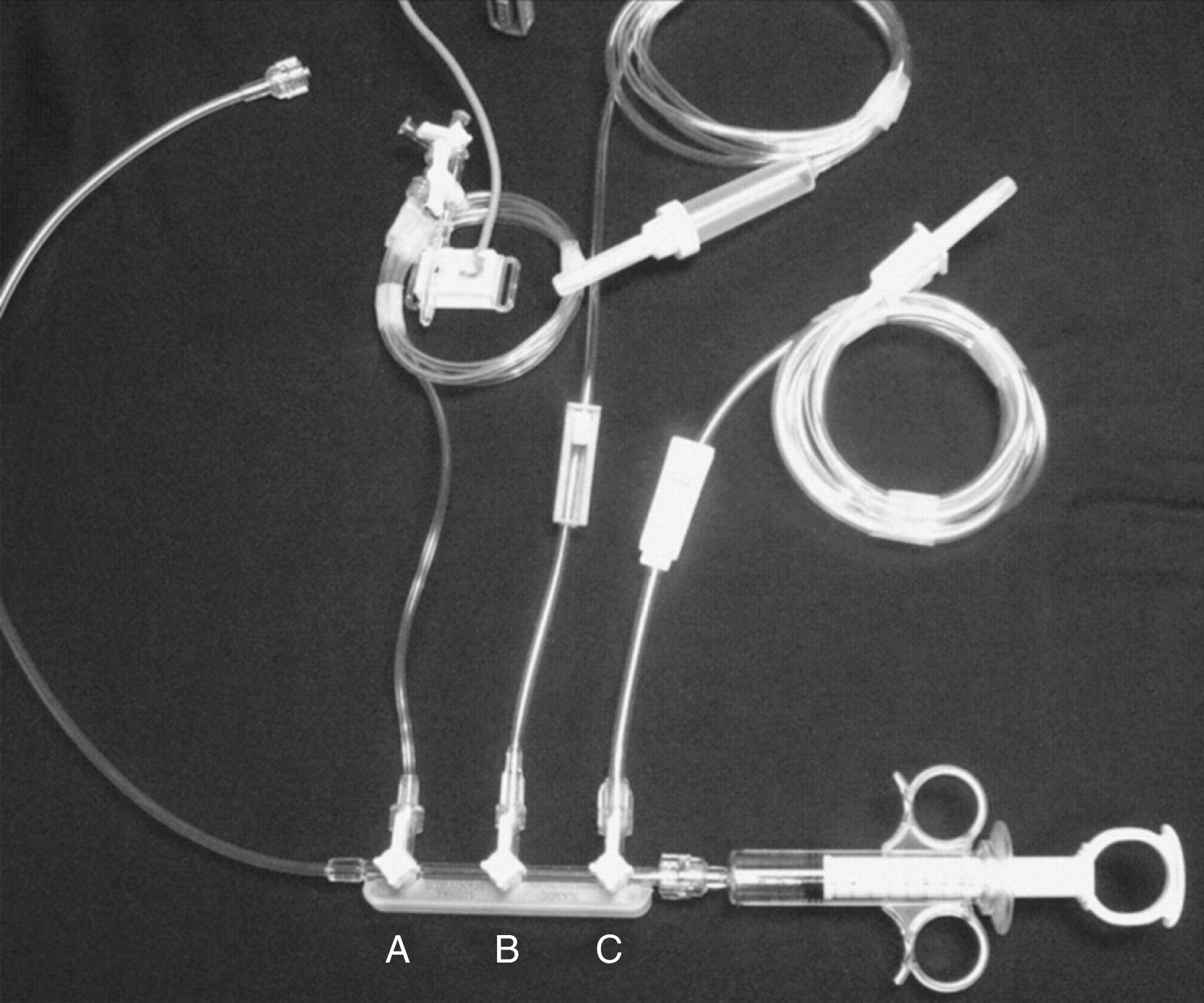
The ability to perform high-quality arteriography with the use of dilute contrast material should not be underestimated. Contrast agents, many of which are nephrotoxic, should always be used conservatively regardless of renal function. Establishing this habit helps to prevent injury to patients with mild renal disease not yet manifested by abnormal laboratory values. In smaller arteries (e.g., the common carotid artery or tibial arteries), 3 to 4 mL of diluted contrast material (1:1 mixture of contrast material and normal saline) should be sufficient to give a high-quality arteriographic image. The learning curve for maximizing proper use of a manifold is not very steep, and after it is mastered, optimal arteriographic images can be obtained rapidly with minimal volume of contrast material. Typical injection methods, rates, and volumes of contrast agent are detailed in Table 27.2 .
| Location | Suggested Method | Injection Rate (mL/s) | Total Volume (mL) |
|---|---|---|---|
| Aortic arch | Power injection | 20 | 40 |
| Selective carotid | Hand or power injection | 3–5 | 5–10 |
| Selective vertebral | Hand injection | 2–4 | 2–4 |
| Selective subclavian or brachial | Hand or power injection | 5–10 | 10 |
| Abdominal aorta | Power injection | 20 | 40 |
| Renal or mesenteric | Hand injection | 3–5 | 5–10 |
| Iliac artery | Hand or power injection | 10 | 10 |
| Infrainguinal segments | Hand or power injection | 5–10 | 10 |
| Aorta to pedals, stepped run | Power injection | 20 | 90 a |
a Full-strength contrast agent; all others typically performed with a half-strength contrast agent when digital subtraction angiography is used.
Arteriographic imaging in the modern era is synonymous with digital subtraction angiography (DSA). The basic concept behind DSA involves a recording technique by which the captured fluoroscopic image is amplified and digitized. With advanced computer data processing capability, multiple manipulations of the stored data can be performed to optimize image quality.
Some of the commonly used post-processing capabilities are subtraction, masking, pixel shifting, and view tracing. Other tools, such as roadmapping and unsubtracted image referencing, can assist in guiding wires and catheters during the actual procedure. Not only do these techniques optimize detail of vessel visualization, but their use can also reduce the amount of contrast and radiation utilized.
Become a Clinical Tree membership for Full access and enjoy Unlimited articles
If you are a member. Log in here